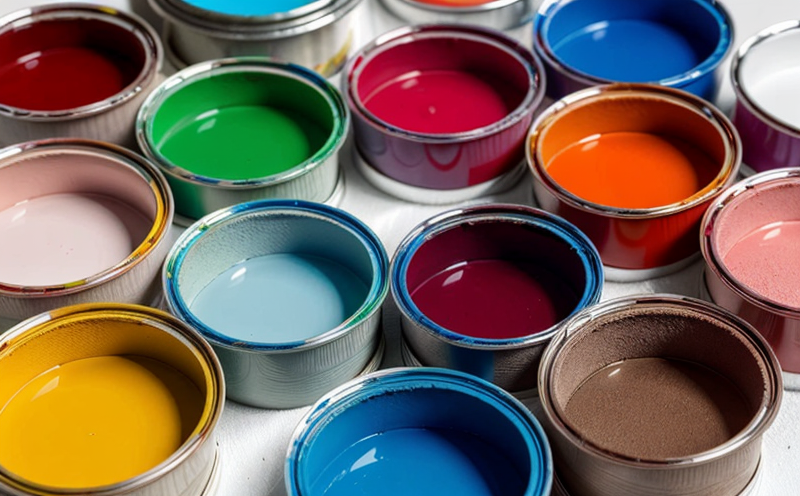Paint Chipping and Flaking Safety Evaluation
Paint chipping and flaking are significant concerns in toy manufacturing due to the potential ingestion by children. The safety evaluation of paint on toys is a critical aspect of ensuring that products comply with international safety standards, particularly those set forth by organizations like ASTM, EN, and ISO.
The process involves several steps designed to identify and mitigate risks associated with chipping or flaking paint. First, the toy's surface is carefully inspected for any visible signs of paint chipping or flaking under controlled conditions. This inspection helps in identifying areas where paint might be more susceptible to wear and tear.
The next step involves laboratory testing using standardized methods. Specimens are prepared by cutting small pieces from various parts of the toy that could come into contact with a child's mouth, such as handles or buttons. The specimens are then subjected to mechanical abrasion tests, where they are exposed to repeated rubbing against abrasive surfaces under controlled conditions.
The abrasion test simulates real-world scenarios in which toys may be handled and played with by children. This process helps determine the durability of the paint coating and its resistance to chipping or flaking. Additionally, colorfastness tests are conducted to ensure that any potential particles released from the paint do not discolor other parts of the toy or adjacent surfaces.
Once the mechanical abrasion testing is complete, the specimens are examined for signs of paint chipping or flaking under high magnification microscopes. This examination allows for a detailed analysis of the extent and pattern of any paint loss. The results from these tests are then compared against established safety standards to ensure that the toy meets all regulatory requirements.
Furthermore, color stability tests are conducted to assess whether the paint maintains its original color over time and under various environmental conditions. This is crucial in preventing the release of potentially harmful pigments or chemicals into children's mouths when they chew on the toy. The tests also ensure that any changes in color do not occur at a rate that could be considered dangerous.
The final step involves reporting the findings to the client, providing detailed insights into the paint's performance during the testing process. This report includes photographs of the test specimens before and after the abrasion test, along with quantitative data on the amount and pattern of chipping or flaking. The report also specifies any deviations from accepted standards, highlighting areas where improvements are necessary.
By adhering to these rigorous testing protocols, we ensure that toys meet the highest safety standards, providing peace of mind for parents and regulatory bodies alike. This approach not only protects children but also helps manufacturers maintain a competitive edge in the market by demonstrating their commitment to quality and safety.
Scope and Methodology
| Step | Description |
|---|---|
| Visual Inspection | Initial examination of the toy's surface for visible signs of paint chipping or flaking. |
| Specimen Preparation | Cutting small pieces from various parts of the toy that could come into contact with a child's mouth. |
| Mechanical Abrasion Testing | Exposing specimens to repeated rubbing against abrasive surfaces under controlled conditions. |
| Microscopic Examination | Examining the specimens for signs of paint chipping or flaking using high magnification microscopes. |
| Colorfastness Tests | Evaluating the color stability of the paint under various environmental conditions. |
| Reporting | Documenting findings and comparing results against established safety standards. |
Industry Applications
The Paint Chipping and Flaking Safety Evaluation service is essential for toy manufacturers, ensuring compliance with international safety regulations. This evaluation helps in identifying potential risks early on, allowing for corrective actions to be taken before products reach the market.
Besides toys, this service can also be applied to other consumer goods like furniture, electronics, and sporting equipment, where paint or coatings may come into contact with a child's mouth. It is particularly relevant in sectors that target younger audiences, ensuring that all products are safe for use.
The insights gained from this evaluation can inform the design and manufacturing processes, leading to more durable and safer products. This not only enhances consumer trust but also helps manufacturers avoid costly recalls and legal issues associated with non-compliance.
Environmental and Sustainability Contributions
The Paint Chipping and Flaking Safety Evaluation service plays a crucial role in promoting environmental sustainability by ensuring that toys and other consumer goods are safe for both children and the environment. By identifying potential risks early on, manufacturers can take steps to reduce waste and improve recycling rates.
This evaluation helps in selecting paints and coatings that not only meet safety standards but also have minimal environmental impact. It encourages the use of eco-friendly materials and processes, contributing to a more sustainable manufacturing industry. Furthermore, by ensuring that toys are safe for extended periods, this service supports the overall durability and longevity of products, reducing the need for frequent replacements.
The findings from these evaluations can also guide the development of new, safer and more sustainable products, fostering innovation in the toy and consumer goods industries. This commitment to sustainability not only benefits the environment but also enhances the reputation of manufacturing companies, making them more attractive to environmentally conscious consumers.





